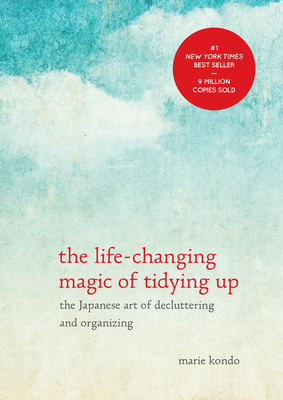The Life-Changing Magic of Tidying Up: The Japanese Art of Decluttering and Organizing
Marie Kondō

As you can see from my Dad’s comment on my status update, my wife and I were already fairly committed minimalists before reading this book. We live in a small apartment, and about eighteen months ago, we moved from New York to California, and got rid of a huge amount of our stuff in the process. (We moved by mailing ourselves five boxes.) That experience was extremely influential for my own relationship with possessions, in a way that I think is quite consistent with many of the points that MK makes. I had never really felt like my stuff was a problem, but after I got rid of so much of it and found that I could live perfectly fine without it, that made me happy. There was a certain pride of accomplishment, not so different from the feeling of going backpacking. There was also a certain sense of rebirth and immediacy, a freedom from the “dead hand of the past.” (Incidentally, does anyone know a source for that phrase? I thought it was Marx, but it looks like I’m wrong. Google is indicating Thomas Jefferson, but I can’t find the source.) I can probably best illustrate it through books, which we really culled. I had kept around a lot of books that I “sort of” planned to read, except that I hadn’t read them in five years (=I was never going to read them). A lot of them had to do with the person I used to be–not that I had changed so drastically, but enough to make a difference. I love the feeling of not having a long backlog of books that I “should” read, and just going to the library to find what I want to read now. (This may be my own personal neurosis.)
At any rate, Kondo talks about a lot of similar things. Despite not having a lot of stuff, I tried her method and ended up getting rid of quite a bit of stuff. Her advice to keep only what “sparks joy” when you hold it sounds very wishy-washy, but I found it to be really effective in practice. I also think it is a good counterweight to my “Depression-era mentality” (once so dubbed by a friend)–I can get rid of clothes that I don’t exactly like, even if they are not 100% worn out. I also started using her method of folding and storing clothes, which I really like. It is nice to be able to see everything in a drawer when you open it (and know how many shirts you have!). Overall, I got a lot more into all of it than I had expected.
I think that both reducing possessions and tidying them (finding one place for each thing) are enjoyable for me because they are ways of cultivating mindfulness. Pamela Druckerman (she of the bebe) recently wrote a “contra-Kondo” op-ed in the NYT (http://www.nytimes.com/2015/02/16/opi...). I was surprised at how weak her conclusion was. Here it is:
But the more stuff I shed, the more I realize that we de-clutterers feel besieged by more than just our possessions. We’re also overwhelmed by the intangible detritus of 21st-century life: unreturned emails; unprinted family photos; the ceaseless ticker of other people’s lives on Facebook; the heightened demands of parenting; and the suspicion that we’ll be checking our phones every 15 minutes, forever. I can sit in an empty room, and still get nothing done.
It’s consoling to think that, beneath all these distractions, we’ll discover our shining, authentic selves, or even achieve a state of “mindfulness.” But I doubt it. I’m starting to suspect that the joy of ditching all of our stuff is just as illusory as the joy of acquiring it all was. Less may be more, but it’s still not enough.
If she is arguing that “just cleaning up” won’t change anything, I agree with her. But I think her language is telling. She refers to “achieving” a state of mindfulness (and why the scare quotes?) beneath all the distractions. For me, mindfulness is not something to achieve, but to practice. Kondo is very clear that her method is about changing your relationship with your possessions, not just changing your methods. And though her book is very focused, I wouldn’t be surprised if she also advocated taking steps to simplify other aspects of your life–checking email less often, not logging on to Facebook, etc. Ryan Nicodemus, who Druckerman cites as a de-cluttering guru, writes about that kind of stuff all the time.
Anyway…regardless of whether it’s “life-changing”, this book is also a very enjoyable read. Kondo has an appealing directness. She retains a unique voice, without falling into the “generic good feature writer” voice that so much non-fiction is written in. She talks a lot about her experiences as a kid who was obsessed with tidying, so she comes across as very quirky, but also fully comfortable with herself. She talks fairly openly about objects having feelings and dispositions, which can seem weird, but it also has a certain charm. (I was reminded a lot of the fun animated short film “Tsukumo.") The jeweler who made our wedding rings also talked to us about stones being alive. I can’t say that I think either of them is right, exactly, but I guess I feel like there’s value in taking that perspective. I suppose it is also a method of cultivating mindfulness–you will be much more mindful of a living thing than an inert piece of matter.